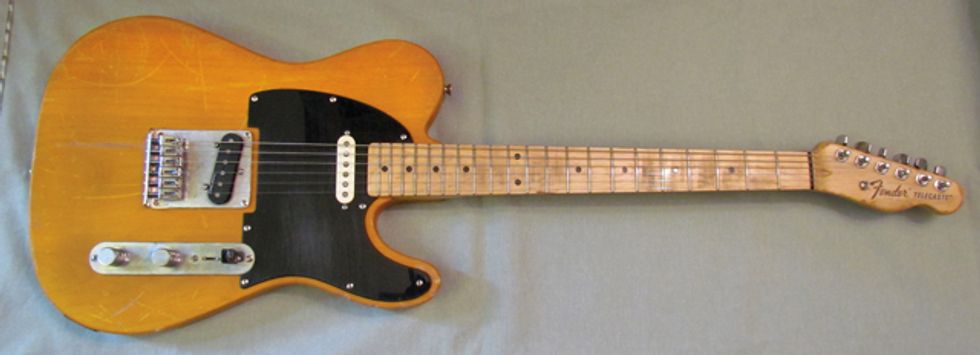Made by Squier—Fender’s budget brand—the Affinity Telecaster is an entry-level version of Leo’s iconic axe. This one has been relic’d and hot-rodded.
For some strange reason, I don’t own any all-original, “normal” Fender Telecaster guitars. All mine are either Tele “inspired” or modified in some way. While looking around on Craigslist the other day, I noticed this intriguing Tele. Apparently someone had taken a fairly new butterscotch Squier Affinity Telecaster, relic’d it, removed all traces of “Squier” from it, and then stuck a Fender decal on the headstock. The seller knew it was actually a Squier and listed it as such, so there was no deception going on. The pictures of the guitar just looked way too cool for me to pass up, plus it was fairly cheap.
So I called the owner and arranged to meet him at his place of work, which was a lot closer to me than going to his home. It turned out he was in law enforcement, so I wound up in the police department parking lot. Whoa! At first I was a little nervous, but he turned out to be a really nice guy and we ended up chatting during his lunch break about music and guitars. I paid him his asking price of $150 for the guitar, which also included a very nice reissue tweed hard-shell case. I figured the guitar was worth about $100 and the case $50. That’s bottom-feeder territory for sure.
LEFT: A close-up of the body scars and distressed metal parts. The upgraded Duncan pickups are identical to those Jerry Donahue has in his
signature Fender Tele. RIGHT: All references to Squier and Affinity have been banished, and a Fender decal now graces the headstock.
Although in general I like stock Squier Teles, I’m not a big fan of their neck pickups, which tend to sound a bit “wooly” and dull to me. I decided to take the guitar to my tech, Jack Dillen, and have him replace both pickups with a set of Seymour Duncans I had lying around. The Duncans I gave Jack were a Jerry Donahue model bridge pickup and an Alnico II Pro Strat pickup for the neck, the same type of pickups on Jerry’s signature model guitars. This gave me a perfect opportunity to finally test-drive the pickups (and get my buddy Jerry off my back about trying them).
Jack had the guitar ready the following week. When I played it through Jack’s Fender Pro Junior, I knew right away it was a good move to replace the pickups. I seemed to get a lot more Roy Buchanan-inspired harmonics in the bridge position, as well as modern, snappy Strat-like blues and jazz tones from the neck pickup. Yeah baby, that’s what I’m talking about!
I also like that Squier offers satin finishes on their maple fretboards and necks. It makes the neck less sticky when your hands get sweaty, and it feels better than the heavy polyurethane finishes on most maple fretboards. This guitar is most definitely a keeper now.
Bottom Feeder Tip #367: If you like the way a guitar plays, but aren’t wild about its sound, it pays to replace the stock pickups with some really good ones. Pickups are the guitar’s engine, and I feel like this one went from a Mustang to a Shelby Cobra!
 Will Ray
is a founding
member of the
Hellecasters guitar-twang
trio. He also does guitar
clinics promoting his
namesake G&L signature
model 6-string, and produces
artists and bands at his studio in
Asheville, North Carolina. You can contact
Will on Facebook and at willray.biz.
Will Ray
is a founding
member of the
Hellecasters guitar-twang
trio. He also does guitar
clinics promoting his
namesake G&L signature
model 6-string, and produces
artists and bands at his studio in
Asheville, North Carolina. You can contact
Will on Facebook and at willray.biz.








![Rig Rundown: Russian Circles’ Mike Sullivan [2025]](https://www.premierguitar.com/media-library/youtube.jpg?id=62303631&width=1245&height=700&quality=70&coordinates=0%2C0%2C0%2C0)


























